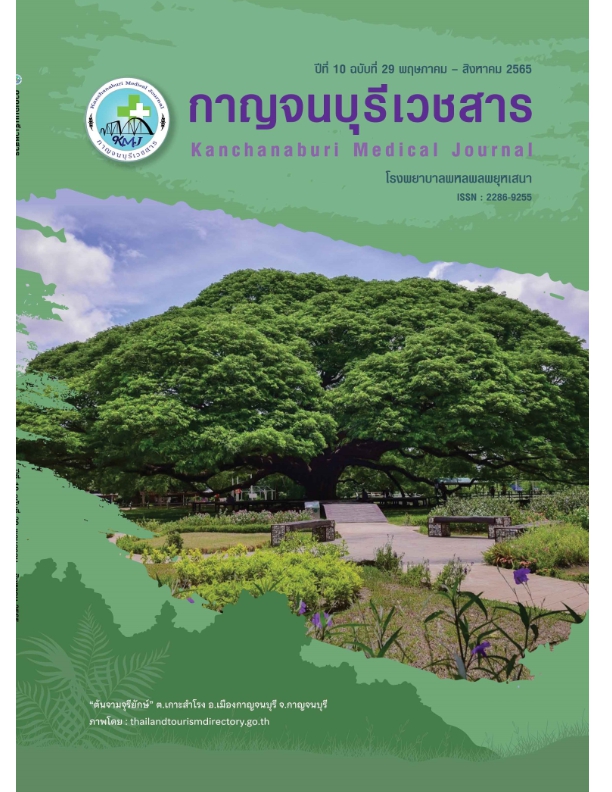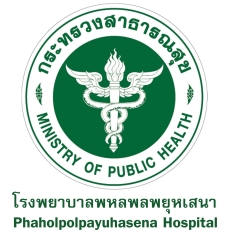อาการแสดงเชื้อก่อโรคและความไวต่อยาต้านจุลชีพ ในผู้ป่วยเด็กโรคติดเชื้อทางเดินปัสสาวะ ของโรงพยาบาลพหลพลพยุหเสนา
บทคัดย่อ
โรคติดเชื้อทางเดินปัสสาวะเป็นโรคที่พบบ่อยในเด็ก การวินิจฉัยที่ล่าช้าหรือรักษาไม่เหมาะสม จะนำไปสู่ภาวะแทรกซ้อน เช่น การเกิดรอยแผลเป็นที่ไต ความดันโลหิตสูง และโรคไตเรื้อรังได้ เชื้อก่อโรคที่พบบ่อย ได้แก่ Escherichia coli ซึ่งมีรายงานการเกิดเชื้อดื้อยาที่มากขึ้น การทราบข้อมูลของเชื้อและความไวต่อยาต้านจุลชีพในแต่ละพื้นที่จะช่วยให้การเลือกใช้ยาต้านจุลชีพเป็นไปอย่างเหมาะสมมีวัตถุประสงค์เพื่อศึกษาความไวต่อยาต้านจุลชีพในผู้ป่วยเด็กโรคติดเชื้อทางเดินปัสสาวะ และศึกษาถึงเชื้อก่อโรคที่พบ รวมทั้งความผิดปกติของระบบทางเดินปัสสาวะแต่กำเนิดวิธีการศึกษาเป็นการศึกษาแบบย้อนหลังในผู้ป่วยเด็กที่ได้รับการวินิจฉัยว่าเป็นโรคติดเชื้อทางเดินปัสสาวะ อายุ 1 เดือนถึง 14 ปี ระหว่างปี พ.ศ. 2558-2564ที่ได้รับการรักษาในโรงพยาบาลพหลพลพยุหเสนา
ผลการศึกษา มีผู้ป่วยจำนวน 94 ราย เป็นเพศชาย 44 ราย (ร้อยละ 46.81) ค่ามัธยฐานของอายุ เท่ากับ 1.04 (0.17, 14.33) ปี เชื้อก่อโรคที่พบมากที่สุด คือ Escherichia coli (ร้อยละ89.36) โดยพบกลุ่ม extended-spectrum β-lactamase (ESBL) producing organisms สูงถึงร้อยละ 26.6 ความไวของเชื้อ Escherichia coli ต่อยาต้านจุลชีพเป็นดังนี้ ampicillin ร้อยละ 10.53, ceftriaxone ร้อยละ 72.62 และ amikacin ร้อยละ 100 ผู้ป่วยได้รับการตรวจrenal ultrasound 85 ราย พบกรวยไตโป่งพอง 20 ราย (ร้อยละ23.53) ผู้ป่วยได้รับการตรวจ voiding cystourethrogram33 ราย พบภาวะปัสสาวะไหลย้อน 7 ราย (ร้อยละ 21.21) ผู้ป่วยกลุ่ม ESBL producing organisms มีประวัติได้รับยาต้านจุลชีพและนอนโรงพยาบาลภายใน 3 เดือนมากกว่า, ได้ยาต้านจุลชีพทางเส้นเลือดนานกว่า และเปลี่ยนยาต้านจุลชีพมากกว่าอีกกลุ่มอย่างมีนัยสำคัญทางสถิติ (P<0.05)
เอกสารอ้างอิง
Lashkar MO, Nahata MC. Antimicrobial Pharmacotherapy Management of Urinary Tract Infections in Pediatric Patients. The Journal of pharmacy technology: jPT: official publication of the Association of Pharmacy Technicians. 2018;34(2):62-81.
Mirsoleymani SR, Salimi M, Shareghi Brojeni M, Ranjbar M, Mehtarpoor M. Bacterial pathogens and antimicrobial resistance patterns in pediatric urinary tract infections: a four-year surveillance study (2009-2012). International journal of pediatrics. 2014;2014:126142.
Tullus K, Shaikh N. Urinary tract infections in children. Lancet (London, England). 2020;395(10237):1659-68.
Simões ESAC, Oliveira EA, Mak RH. Urinary tract infection in pediatrics: an overview. Jornal de pediatria. 2020;96 Suppl 1:65-79.
Morello W, La Scola C, Alberici I, Montini G. Acute pyelonephritis in children. Pediatric nephrology (Berlin, Germany). 2016;31(8):1253-65.
Okarska-Napierała M, Wasilewska A, Kuchar E. Urinary tract infection in children: Diagnosis, treatment, imaging - Comparison of current guidelines. Journal of pediatric urology. 2017;13(6):567-73.
Ammenti A, Alberici I, Brugnara M, Chimenz R, Guarino S, La Manna A, et al. Updated Italian recommendations for the diagnosis, treatment and follow-up of the first febrile urinary tract infection in young children. Acta paediatrica (Oslo, Norway: 1992). 2020;109(2):236-47.
Leung AKC, Wong AHC, Leung AAM, Hon KL. Urinary Tract Infection in Children. Recent Pat Inflamm Allergy Drug Discov. 2019;13(1):2-18.
Thergaonkar RW, Hari P. Current Management of Urinary Tract Infection and Vesicoureteral Reflux. Indian journal of pediatrics. 2020;87(8):625-32.
Kaufman J, Temple-Smith M, Sanci L. Urinary tract infections in children: an overview of diagnosis and management. BMJ Paediatr Open. 2019;3(1):e000487.
Schmidt B, Copp HL. Work-up of Pediatric Urinary Tract Infection. The Urologic clinics of North America. 2015;42(4):519-26.
Roberts KB, Subcommittee on Urinary Tract Infection SCoQI, Management. Urinary Tract Infection: Clinical Practice Guideline for the Diagnosis and Management of the Initial UTI in Febrile Infants and Children 2 to 24 Months. Pediatrics. 2011;128(3):595-610.
Stein R, Dogan HS, Hoebeke P, Kočvara R, Nijman RJ, Radmayr C, et al. Urinary tract infections in children: EAU/ESPU guidelines. European urology. 2015;67(3):546-58.
Buettcher M, Trueck J, Niederer-Loher A, Heininger U, Agyeman P, Asner S, et al. Swiss consensus recommendations on urinary tract infections in children. Eur J Pediatr. 2021;180(3):663-74.
Woo B, Jung Y, Kim HS. Antibiotic Sensitivity Patterns in Children with Urinary Tract Infection: Retrospective Study Over 8 Years in a Single Center. Child Kidney Dis. 2019;23(1):22-8.
Amornchaicharoensuk Y. Clinical Characteristics And Antibiotic Resistance Pattern Of Pathogens In Pediatric Urinary Tract Infection. The Southeast Asian journal of tropical medicine and public health. 2016;47(5):976-82.
Pouladfar G, Basiratnia M, Anvarinejad M, Abbasi P, Amirmoezi F, Zare S. The antibiotic susceptibility patterns of uropathogens among children with urinary tract infection in Shiraz. Medicine. 2017;96(37):e7834.
Topaloglu R, Er I, Dogan BG, Bilginer Y, Ozaltin F, Besbas N, et al. Risk factors in community-acquired urinary tract infections caused by ESBL-producing bacteria in children. Pediatric nephrology (Berlin, Germany). 2010;25(5):919-25.
Kizilca O, Siraneci R, Yilmaz A, Hatipoglu N, Ozturk E, Kiyak A, et al. Risk factors for community-acquired urinary tract infection caused by ESBL-producing bacteria in children. 2012;54(6):858-62.
ดาวน์โหลด
เผยแพร่แล้ว
รูปแบบการอ้างอิง
ฉบับ
ประเภทบทความ
สัญญาอนุญาต
ลิขสิทธิ์ (c) 2022 โรงพยาบาลพหลพลพยุหเสนา

อนุญาตภายใต้เงื่อนไข Creative Commons Attribution-NonCommercial-NoDerivatives 4.0 International License.
บทความที่ได้รับการตีพิมพ์เป็นลิขสิทธิ์ของโรงพยาบาลพหลพลพยุหเสนา
ข้อความที่ปรากฏในบทความแต่ละเรื่องในวารสารวิชาการเล่มนี้เป็นความคิดเห็นส่วนตัวของผู้เขียนแต่ละท่านไม่เกี่ยวข้องกับโรงพยาบาลพหลพลพยุหเสนาและบุคลากรท่านอื่น ๆ ในโรงพยาบาลฯ แต่อย่างใด ความรับผิดชอบองค์ประกอบทั้งหมดของบทความแต่ละเรื่องเป็นของผู้เขียนแต่ละท่าน หากมีความผิดพลาดใด ๆ ผู้เขียนแต่ละท่านจะรับผิดชอบบทความของตนเอง





